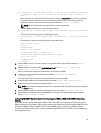
a. vicfg-snmp.pl --server <ESX_IP_addr> --username root --password <password>
-c <community name> -p X –t <Destination_IP_Address> @162/ <community
name>
Where represents an unused port. To find an unused port, check the /etc/services file for the port assignment
for defined system services. Also, to make sure that the port selected is not currently being used by any
application or service, run the following command on the ESX server: netstat –a command
NOTE: Multiple IP addresses can be entered using a comma-separated list.
To enable VMWare SNMP service, run the following command:
b. vicfg-snmp.pl --server <ESX_IP_addr> --username root --password <password>
- E
To view the configuration settings, run the following command:
c. vicfg-snmp.pl --server <ESX_IP_addr> --username root --password <password>
-s
The following is an example of the configuration file, after modification:
<?xml version="1.0">
<config>
<snmpSettings>
<enable> true </enable>
<communities> public </communities>
<targets> 143.166.152.248@162/public </targets>
<port> 167 </port>
</snmpSettings>
</config>
2. Stop the SNMP service if it is already running on your system by entering the following command: service
snmpd stop
3. Add the following line at the end of the /etc/snmp/snmpd.conf file: proxy -v 1 -c public udp:
127.0.0.1:X .1.3.6.1.4.1.6876
Where X represents the unused port specified above, while configuring SNMP.
4. Configure the trap destination using the following command: <Destination_IP_Address>
<community_name>
The trapsink specification is required to send traps defined in the proprietary MIBs.
5. Restart the mgmt-vmware service with the following command: service mgmt-vmware restart
6. Restart the snmpd service with the following command: service snmpd start
NOTE: If the srvadmin is installed and the services are already started, restart the services as they depend on
the snmpd service.
7. Run the following command so that the snmpd daemon starts on every reboot: chkconfig snmpd on
8. Run the following command to ensure that the SNMP ports are open before sending traps to the management
station: esxcfg-firewall -e snmpd.
Configuring The SNMP Agent On Systems Running Supported VMware ESXi 4.X And ESXi 5.X Operating
Systems
Server Administrator supports SNMP traps on VMware ESXi 4.X and ESXi 5.X. If a stand-alone license is only present,
SNMP configuration fails on VMware ESXi operating systems. Server Administrator does not support SNMP Get and Set
operations on VMWare ESXi 4.X and ESXi 5.X as the required SNMP support is unavailable. The VMware vSphere
Command- Line Interface (CLI) is used to configure systems running VMware ESXi 4.X and ESXi 5.X to send SNMP traps
to a management station.
23


















